Homing Pigeon: History And Breed Guide
A homing pigeon flew for 2 days to deliver an important message to the Allied command during World War II. The note prevented the demise of thousands of Allied soldiers. That warhero pigeon was called the “Duke of Normandy.”
According to the PDSA website, Duke didn’t stop while facing “bullets, bombs, and rain” and did what it was trained to do – delivering messages and even supplies.
After the war ended, Duke received a medal of honor for its bravery and service to the army.
Cool as its name sounds, the Duke of Normandy was from an even cooler breed of pigeons known as the Homing pigeons. These pigeons are famous for their navigating abilities.
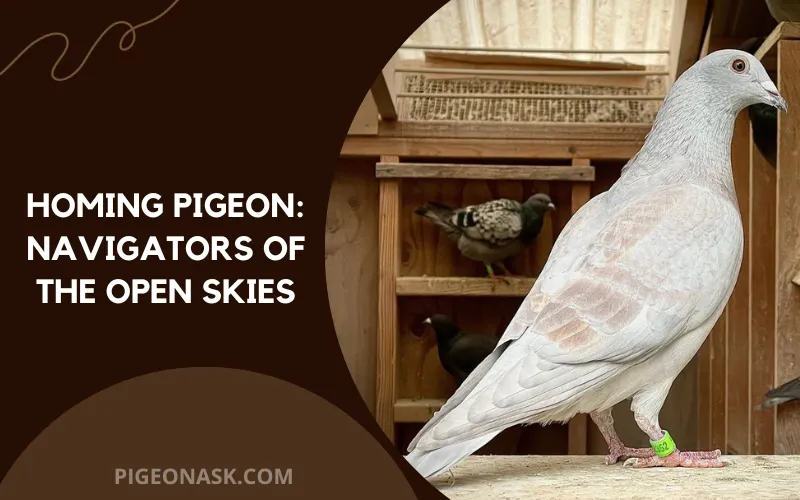
Moreover, they can fly at a speed of 80 km per hour and up to 500 kilometers or more if needed.
Keep reading if you are willing to learn more about this breed, such as how they came to be, how to breed and train them, their physical traits, special features, migration, their accommodation, cost of raising, etc.
Homing Pigeon Profile
| Name | Homing Pigeon |
|---|---|
| Scientific Name: | Columba livia domestica |
| Common Names: | Mail pigeon, Messenger pigeon, Racing homer |
| Origin: | Experts believe their origins to be Egypt, Greece, and the Middle East |
| Size: | 10 inches (1 ft approx..) |
| Weight: | 21 Ounces |
| Lifespan: | 1. Domestic: 15-20 years 2. Wild: 5 years |
| Physical Features: | Round and slender body; round head and short neck and tail; various patterns and colors in feathers |
| Temperament: | Calm and gentle |
| Behaviors: | Loyal and can make bonds with owners; very social; mate for life; protective of their flocks |
| Special Features: | Homing instinct; long-distance flying capability; can remember people’s faces |
| Breeding and Maintenance: | Breed twice a year; 15 squabs per year; take 17 days to hatch; easy and inexpensive to maintain |
| Common or Popular Varieties: | American racing homer, Belgian homer, White flying homer, Dutch homer, etc. |
Interested in similar topics on pigeon breed:
Overview Of Homing Pigeon
Homing pigeons are one of the popular fancy pigeon breeds that originated from wild rock doves. Fancy pigeons are precisely what the name sounds like – pigeons that are fancy and possess unique and special traits, unlike feral pigeons.
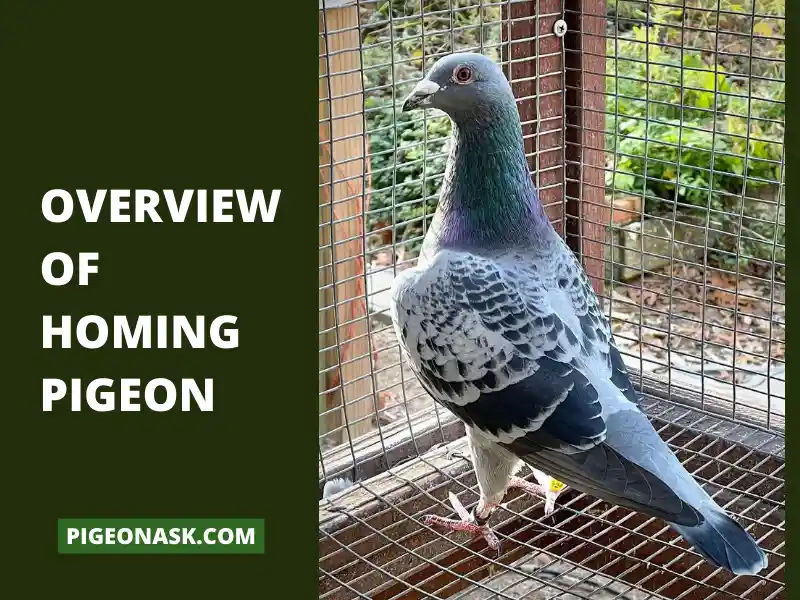
Homing pigeons, being a fancy pigeon breed, are no different in terms of having special qualities. They have an acute homing instinct, which makes them a perfect choice for sending messages around the globe.
Since the ancient period, as far as 2500 BC, people have been doing precisely that with this breed, which earned them the nicknames of mail or messenger pigeon.
With years of training from an early age, breeders tap into these birds’ innate capability of remembering places to send messages afar, along with many other chores.
They have been used in wars, ancient Olympics, post offices, pigeon races, personal communications, etc., since long ago.
Some common breeds of homing pigeons are American racing homer, Belgian homer, White flying homer, Dutch homer, etc.
We have covered an in-depth article on “Homer and Hen Pigeons“; if interested, you can read our article!
The History And Origin of Homing Pigeons
People came to be aware of homing pigeons’ abilities long ago. Historians say the first record of using homing pigeons as pigeon posts was five thousand years ago in ancient Egypt. They were used as pigeon posts.
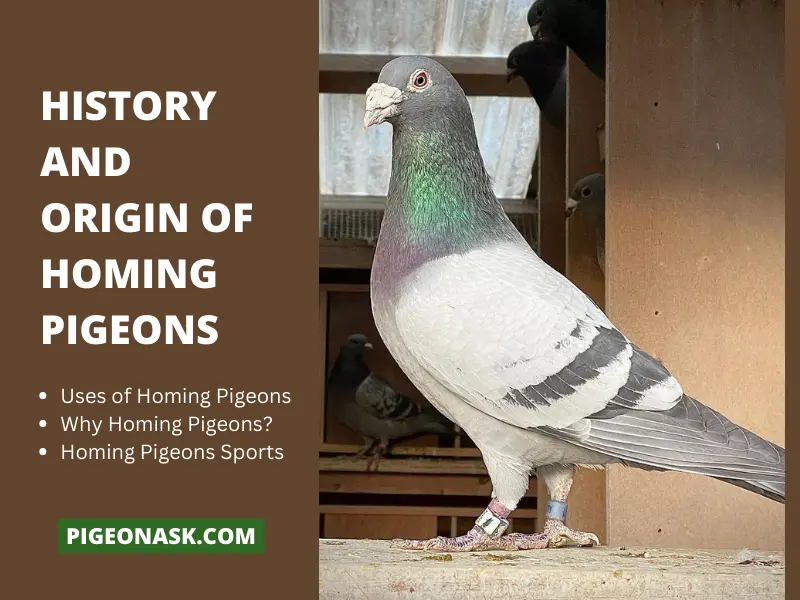
Emperors such as Genghis Khan, Tipu Sultan, Julius Caesar, the last German emperor Kaiser Wilhelm II, etc., extensively utilized these majestic birds’ remarkable ability to send mail.
The pigeon holes Tipu Sultan built for his prized Homing pigeons in Jamia Masjid, located at his headquarters, can still be seen today.
Uses of Homing Pigeons
Pigeon post was a common practice where people would use homing pigeons as messengers for their natural ability to come back home.
What they would do is they would bind the messages to their legs and set free, and these pigeons would reach their destination on their own.
By far, the most popular use of homing pigeons has been for military communication during wars. Many pigeons, like our war hero, the Duke of Normandy, were used by the Allied and Axis powers during World War 1 and 2.
Funnily enough, the Homing pigeons have also been used in theft. Thieves would train their pigeons to steal important stuffs, especially money, and after stealing, the birds would simply return to their home.
Why Homing Pigeons?
Once set free for the task Homing pigeons were trained to do and the destination they were prepared to reach, nothing, not even bullets and bombs, could stop them.
And it was particularly challenging when the best marksmen from both sides were assigned the sole duty of shooting down any pigeon on sight.
During World War 2, the Army Signal Corps used pigeons to send messages to other companies with a success rate of 96 percent, if you can believe it!
The data necessarily means that of every 100 homing pigeons they dispatched, 96 successfully made it to the destination.
Homing Pigeons Sports
Pigeon enthusiasts have been organizing pigeon races for thousands of years.
Around 1818, in modern Brussels, locals organized a grand pigeon race known as the Cannonball Run, where many people from around the globe participated with their best pigeons.
In today’s world, pigeon races and exhibitions are immensely commercial and popular, attracting many viewers and participants worldwide.
How The Homing Pigeons Were Bred And Developed?
The origins of homing pigeons can be traced back to wild rock pigeons that gravitated towards human settlements for food. Over time, these wild birds were domesticated, becoming a protein source and religious sacrifice.
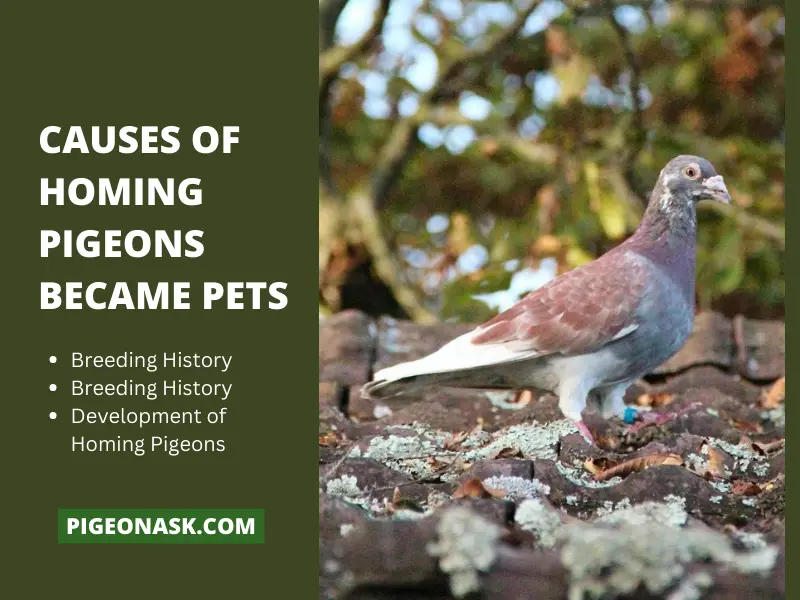
This process of taming laid the foundations for how homing pigeons eventually became beloved pets.
How Homing Pigeons Became Pets?
Wild rock pigeons were searching for food and they understood that they should build their nests near human settlements as food was scarce in the wild, and living near humans meant easy food.
As time went by, pigeons grew docile and became a popular source of protein in Asia and other places. They also became a means of religious sacrifice around Europe.
People started interacting with them more and realized that these majestic birds were more than meat. They were loyal and possessed many special traits and thus became pets.
Breeding History
The homing pigeon is one of the popular breeds of fancy pigeons. In order to understand the breeding of homing pigeons, we need to look at the history of fancy pigeons first.
Before Darwin, it was a common belief that fancy and feral pigeons came from two different ancestors. And it was understandable where that belief came from by just looking at both breeds – they look so different.
However, Darwin said otherwise and proved that all the breeds of pigeons share a single ancestor: the Rock Dove (Columba livia).
He did so by crossbreeding many species of fancy pigeons and creating a diverse range of domestic pigeons.
Although there’s no record, it’s believed that people started crossbreeding hundreds of years ago. The process started once people noticed pigeons’ special traits and how easy it was to get the desired traits.
Development of Homing Pigeons
People started experimenting with all the breeds, crossbreeding them. They knew which traits they wanted and which they didn’t and bred accordingly.
As you can already guess, people also experimented with homing pigeons and gave birth to many exquisite breeds, such as the American racing homer, Belgian homer, White flying homer, Dutch homer, etc.
While heavy crossbreeding incepted many fancy breeds, some pigeons lost their intrinsic qualities during the process.
For example, the carrier pigeons, one of the oldest breeds of fancy pigeons, lost their homing instinct long ago. Nowadays, only the Homers and Racers possess the homing ability as they are distantly a part of the Carriers’ bloodline.
Physical Characteristics And Features
| Characteristic | Description |
|---|---|
| Body Shape | Round (Squabbing Homer), Slender (Belgian Racing Homer) |
| Beak | Strong and thick (e.g., English homing bird, Belgian homers) |
| Head and Neck | Round head with a relatively small neck |
| Weight | Small to medium (around 600 grams or 21 ounces) |
| Height | Sturdy build, up to 10 inches (almost 1 ft) |
| Tail | Short tail with about 10 feathers |
| Feather Variations | Various patterns and colors, e.g., white (Squabbing Homer), blue, yellow, red, black (e.g., English homing breed: black, red, yellow, opal) |
Distribution And Habitat of Homing Pigeons
We will now tell you geographically where we can find homing pigeons.
Moreover, we answer to some common questions regarding their habitat preferences, whether they are migratory, and whether Homing pigeons are an endangered species.

Geographic Distribution
Homing pigeons can be found worldwide, especially in Asia, northern Africa, and Europe. Moreover, their presence is seen in the ancient world, such as Egypt, Rome, Greece, the Middle East, tribal Africa, and India.
Conclusively, homing pigeons have been and still are an epidemic around the world.
Habitat Preferences
Homing pigeons seek a lofty, secure nest space to protect themselves from predators. Also, they prefer to build their nests around readily available food and water sources.
Urban and Rural Habitats
Around the urban areas, the Homing pigeons ensure a haven in people’s attics, ledges, rooftops, window corners, bridges, etc. In the rural areas, they still prefer to stay close to localities for food and water.
They usually choose barns, trees, farms, etc., as their nesting ground. And the wild homers, although rare, nest in bushes, trees, caves, cliffsides, branches, and fallen tree logs.
Migration and Seasonal Movements
The homing pigeons usually don’t migrate seasonally. They, however, may travel a long distance in search of water and food and are very much capable of making the lengthy journey.
Ultimately, they return home with their extraordinary homing power, which remains functional even if they are blindfolded.
Threats and Conservation Status
The growing radio signals of mobile networks and the internet obviously interfere with their homing ability, threatening their ability to navigate and return home and consequently jeopardizing their well-being.
But this was to be sooner or later. Considering the rapid growth of technology, who knows what the future holds for this species?
That said, the Homing pigeons are not an endangered species yet. Their number is still on the safe side.
Behavior And Traits of Homing Pigeons
Below are some of the personality and behavioral traits of wild and domesticated Homing Pigeons. This section also describes their diet, lifespan, breeding, and nesting patterns.
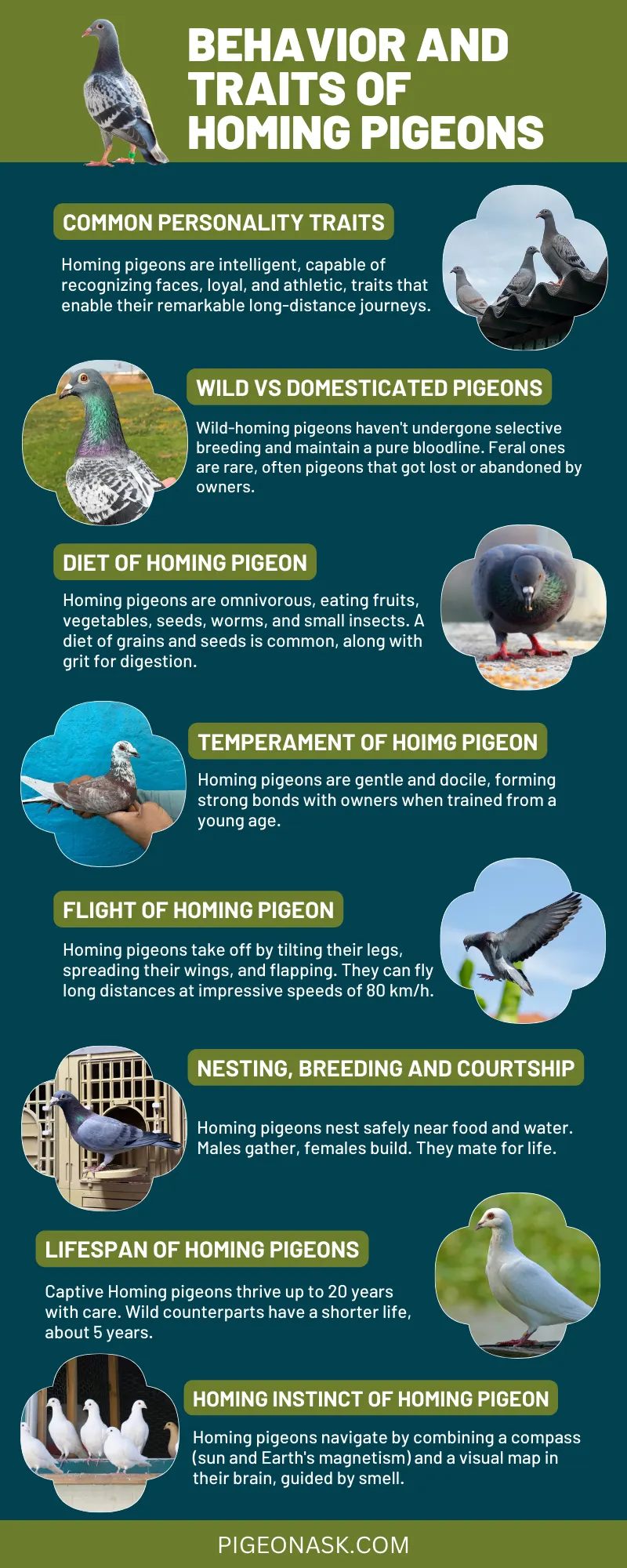
Common Personality Traits
Homing pigeons are intelligent and can remember people’s faces.
Furthermore, they enjoy being around people and are renowned for their loyalty. Homing pigeons are also very athletic, which makes their long journeys feasible.
Differences Between Wild and Domesticated Pigeons
Wild-homing pigeons are not selectively bred to achieve and enhance certain traits like the domesticated homers are. The wild ones have been breeding naturally for thousands of years, which makes their bloodline pure.
That said, it’s incredibly rare to find feral Homing pigeons nowadays; the wild ones are usually the ones that ran away, lost their way home, or were abandoned by owners.
Diet
Homing pigeons are omnivorous. Their diet includes fruits, vegetables, seeds, worms, and small insects.
They prefer a mixture of grains and seeds, which can be found as pigeons feed in supermarkets, and intake crushed stones, known as grits, to aid digestion.
Temperament
Homing pigeons are gentle in nature and docile. Owners can develop a strong bond with them if these birds are trained right from a young age.
Flight
A Homing pigeon’s flight is similar to other birds. They first tilt their legs, spread their wings, and start flapping, which gives them the lift off the ground.
These birds are excellent at flying long miles, which they do at an impressive speed of 80 km per hour.
Nesting, Breeding and Courtship
Homing pigeons hide their nests in an elevated space from predators. While choosing the nesting ground, they make sure water and food are in close proximity.
The male plays an essential part in building the nest. He brings out twigs, hay, and other building materials, and the female will build the nest.
Pigeons usually mate for life. The male sings out for a female.
Plus, he would do a ritual dance around the female by wagging his tail and spreading his feathers. If the female shows interest, they kiss by touching each other’s bills and eventually mate. After mating, they commence building their nest.
A female Homing pigeon lays 2 eggs each breeding cycle. Both the male and female take turns incubating the eggs. It takes them 17 days to hatch an egg. The couple makes around 15 squabs a year.
Large-sized homing pigeons, such as the Squabbing Homing pigeon, can break their eggs while incubating. However, they have a higher reproduction rate than other Homers.
Lifespan of Wild and Domesticated Homing Pigeons
A Homing pigeon raised in farms with proper care, vaccines, and medications can live up to 20 years, whereas a homing pigeon in the wild typically has a lifespan of only 5 years.
Homing Instinct
The defining trait of Homing pigeons is their homing instinct. They can navigate to their home from hundreds of miles away.
Scientists have long established that homing pigeons navigate using a “map and compass” mechanism. To simplify, the Homing pigeons use the sun and the earth’s magnetic field as a compass to maintain the right direction.
As for the mapping mechanism, they build a visual map in their brain and use their smell to determine where they are.
Breeding And Maintenance
Now let’s educate you with the pieces of information and tips regarding raising and breeding, feeding, and housing criteria.
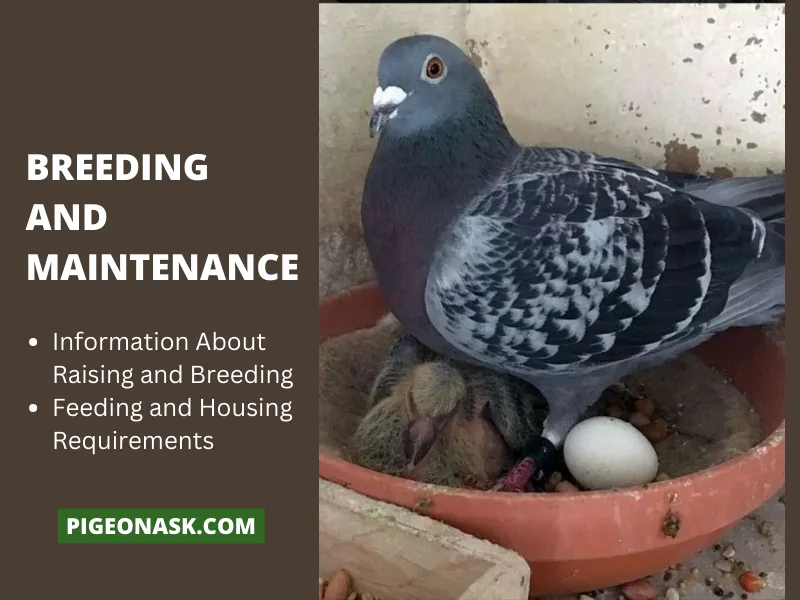
Information About Raising and Breeding
As a pigeon owner myself, I would want my pigeons to be healthy and highly reproductive. And to make that happen, we must ensure the pigeons are being raised properly.
Owners must keep the pigeons safe from predators, give them proper food, consult a pigeon expert for the proper mixture of feed and take them to vets occasionally.
Moreover, during the breeding season, which is by far the most crucial period, owners must take intensive care of their pigeons.
Feeding and Housing Requirements
A pigeon diet requires a significant percentage of protein (16%) and mixtures of grains and seeds to keep them healthy. You should keep veggies and fruits in their diet and always ensure clean water.
Pigeons require crushed oyster shells for calcium and grits for digestion. Therefore, make sure you provide these.
Homing pigeons are very territorial and highly alert regarding keeping their space safe. Make the loft on a higher spot and build small doors to keep them safe from predators.
Keep the lofts dry and clean. If you can provide them with a safe space, the pigeons will be healthier and reproduce more. And this is what we all pigeon owners want.
Final Words
People no longer use the Homing pigeons to send messages, which you can already imagine. The growing number of modern technologies have made them obsolete.
However, the Homing pigeons are still a massive interest amongst enthusiasts, racers, and pigeon sellers.
Throughout the article, we made an effort to give the best picture of homing pigeons regarding their appearance, history, diet, mating and breeding, navigation system, and some popular breeds.
Our only hope is that you have benefitted from this, and only then will our hard work achieve justification.
References:
- https://www.popsci.com/science/article/2013-01/geologist-has-probably-figured-out-how-homing-pigeons-find-their-way-home/
- https://www.nationalgeographic.com/animals/article/130130-homing-pigeon-navigation-animal-behavior-science
- https://theconversation.com/explainer-how-do-homing-pigeons-navigate-25633
- https://www.backyardchickens.com/articles/basic-pigeon-care-feeding-and-housing.68171/
- https://www.mentalfloss.com/article/54844/history-pigeon
- https://kashmirobserver.net/2020/07/06/a-fascinating-history-of-the-carrier-pigeons/
- https://www.militarytimes.com/off-duty/military-culture/2020/12/24/bra-wearing-pigeons-saved-thousands-of-lives-in-wwii/
- https://www.agriculture.com/family/living-the-country-life/how-to-raise-homing-pigeons
